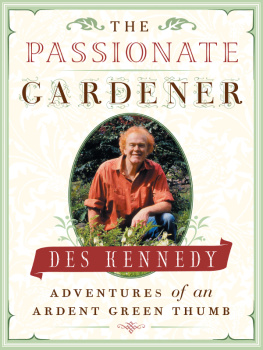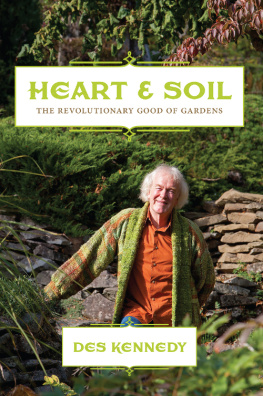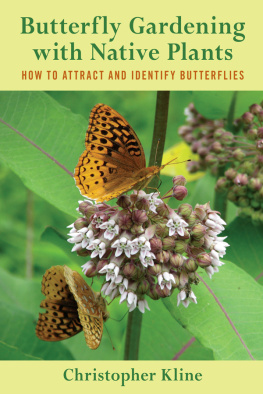The Passionate Gardener

DES KENNEDY

ADVENTURES of an
ARDENT GREEN THUMB

GREYSTONE BOOKS
Douglas & McIntyre Publishing Group
Vancouver/Toronto/Berkeley
Copyright 2006 by Des Kennedy
All rights reserved. No part of this book may be reproduced, stored in a retrieval system or transmitted, in any form or by any means, without the prior written consent of the publisher or a licence from The Canadian Copyright Licensing Agency (Access Copyright). For a copyright licence, visit www.accesscopyright.ca or call toll free to 1-800-893-5777.
Greystone Books
An imprint of Douglas & McIntyre Ltd.
2323 Quebec Street, Suite 201
Vancouver, British Columbia
Canada V5T 4S7
www.greystonebooks.com
Cataloguing data available from Library and Archives Canada
ISBN 978-1-55365-198-7 (pbk.)
ISBN 978-1-926685-48-9 (ebook)
Cover design by Naomi MacDougall
Cover photograph of Des Kennedy by Sandy Kennedy
Portions of several chapters in this book appeared in different form in Gardening Life and GardenWise magazines
We gratefully acknowledge the financial support of the Canada Council for the Arts, the British Columbia Arts Council, and the Government of Canada through the Book Publishing Industry Development Program (BPIDP) for our publishing activities.
For Sandy
WE WILL ENDEAVOUR to shew how the aire and genious of Gardens operat upon humane spirits towards virtue and sanctitie, I meane in a remote, preparatory and instrumentall working. How Caves, Grotts, Mounts, and irregular ornaments of Gardens do contribute to contemplative and philosophicall Enthusiasms; how Elysium, Antrum, Nemus, Paradysus, Hortus, Lucus, &c., signifie all of them rem sacram et divinam; for these expedients do influence the soule and spirits of man, and prepare them for converse with good Angells; besides which, they contribute to the lesse abstracted pleasures, phylosophy naturall and longevitie.
John Evelyn in a letter to Sir Thomas Browne, 1657

Contents



T HE GREAT CZECH writer Karel Capek put it bluntly: Let no one think that real gardening is a bucolic and meditative occupation. It is an insatiable passion, like everything else to which a man gives his heart. Those who have given their heart to a gardenor had their heart stolen by it, more likelyknow full well how insatiable is the passion to which theyve succumbed.
Less clear is how and why gardening so thoroughly captivates us. My own first venture into the garden was not especially promising. For reasons known only to the genius of childhood, I went out one fine day and methodically cut down a whole bed of blooming flowerschrysanthemums, I thinkin my parents garden. We lived those days in a stone cottage on the grounds of a convent school for girls in Woolton Village, Merseyside, a suburb of Liverpool. My father was the farm bailiff, responsible for the crops and animals that supplied the convents kitchen. Nuns move like imposing black ghosts through my dim early memories.
I have a faded photograph of myself as a fair-haired little fellow in short pants standing in a field of cut grass, with fences and large deciduous trees in the background. A hill rises behind meI believe this is Beacon Hill, where signal fires were lit in ancient times. The scent of new-mown hay, the chittering of songbirds in hedgerows, the sight of the moon shining above Beacon Hill touched my childhood soul in a way I would not understand for decades. A passion to garden may have been clandestinely seeded there.
When I was ten years old, the family emigrated from England to Canada, settling in Weston, a suburb of Toronto. This move was ostensibly motivated by my parents desire to provide my brothers and me with better opportunities than those offered to working-class kids in postwar England. I suspect the urge to acquire some land of their own on which to garden was at least a contributing factor in the decision, and within a year our little city lot was chockablock with flowers and vegetables.
By the age of sixteen Id become convinced that I had a religious vocation, had been singled out and called by God Himself to become a priest. The conviction was sufficiently strong that I devoted eight long years to living in monastic seminaries operated by the Passionist Fathers, whose motto was: May the Passion of Jesus Christ be ever in our hearts. Unlike the Trappists and some other monastic orders, the Passionists were indifferent to horticulture, and so the seed continued to lie dormant.
During the latter days of my monastic seclusion, I began imagining myself to be a poet. This diversion may have started innocently enough with reading Gerard Manley Hopkins and John Donne, but it soon embraced William Carlos Williams, Allen Ginsberg, and others of their ilk. Assigned to a monastery in New York City, I fell in with a gang of irreligious poets in the East Village and got swept up in the civil rights/antiVietnam War/Woodstock maelstrom of those turbulent times. Radical politics and poetry were not at all what the Passionists had in mind, and I was defrocked before I was properly frocked.
Cast loose, I started over in Vancouver, on Canadas west coast, trying my hand first at teaching high school and then at working with street kids. There I met an entrancing social worker who was fated to become my life companion. In the flush of young love, I was blissfully unaware that she might be one of Floras enchantresses, sent to lead me by gentle measures back to the garden. Scarcely had our marriage vows been pledged, now thirty-five years ago, than we were on our way out of the city to begin life together on eleven acres of mostly conifer forest on one of British Columbias fabled Gulf Islands.
Although we planned from the outset to grow our own fruits and vegetablesalong with keeping goats, chickens, ducks, geese, and rabbitsthis lifestyle change was to my mind a venture into not so much serious gardening as enlightened husbandry. I imagined living a simple, frugal, tranquil existence, occasionally laboring at a leisurely pace that afforded an abundance of time to get on with my writing.
What in fact occurred was the biographical equivalent of the persistent winter rains that make possible the lush growth of the coastal temperate rain forest. After we built a little house from recycled and hand-hewn materials and were more or less settled, gardening burst into our lives like a howling southeaster. It became for us, as for so many others, Capeks insatiable passion, completely circumscribing how we live. Nowadays, we maintain a large fruit and vegetable garden that supplies much of our food throughout the year. An even larger ornamental garden, about twenty years old, rises in terraced levels in front of the house. Its early character of massed blooming annuals, biennials, and perennials has gradually given way to a more textured, all-season garden of trees, shrubs, grasses, and hardy perennials. Native and wildlife-friendly plants help stitch the garden into the surrounding woodlands, as do using native stone and cedar in our hardscape and designing beds that curve and flow the way the forest landscape does. We are neither great nor expert gardeners. We muddle along, make mistakes, and muddle some more.
Next page
















